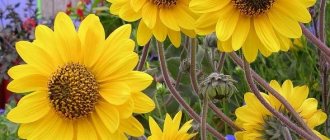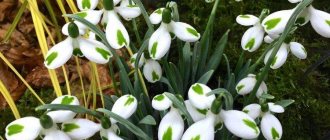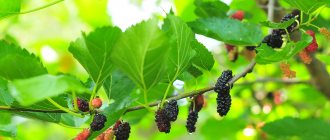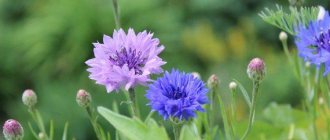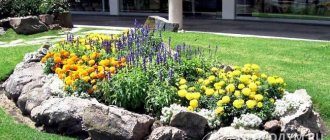Bouquet of cornflowersCornflowers are found in meadows among multi-colored herbs; open spaces with blue cornflowers and red poppies look especially beautiful. They also grow in fields, especially often found among rye crops, now as weeds, but even here their blue heads sway so beautifully among the golden ears.
All this has been said about the most familiar species to us - blue cornflower, an annual plant known to everyone. But its genus is very extensive: almost 500 species of different cornflowers grow in nature.
Pink cornflower Cornflowers, cornflowers, blue flowers - this is what this plant is called in different parts of our country. Let's get to know each other better. Cornflower (Centaurea) is a genus of plants in the Asteraceae family. Found almost everywhere in the northern hemisphere. It is believed that its Latin name comes from the Greek word kentaurion, which means Chiron: this was the name of the famous centaur from ancient Greek myths, the teacher of the famous Hercules and a healer who knew medicinal herbs and their properties.
Ads by
More about the plant
All cornflowers are herbaceous plants, usually having straight, rather tall, branched stems, but there are also plants with recumbent shoots.
Their leaves can be simple or dissected. Cornflower flower Cornflowers have a basket-shaped inflorescence consisting of funnel-shaped flowers of various colors. They are located along the edge, and in the middle, as usual in all Asteraceae, the flowers are tubular.
Features of different types
It is interesting that different types of cornflowers have different root systems.
Some have a long rhizome with branches, for example, soft cornflower. Others produce many root shoots - this is c. Fisher. Still others have a tap root, going deep, like v. Russian. Some species have powerful thick rhizomes. Perennial cornflowers have one more feature - their basal leaves remain green all year round. They grow in 2 periods: in the spring, young leaves appear, which live until the end of summer, and in September-October, others grow and remain until the next spring. The leaves of all species are beautiful, feathery, often pubescent so that they appear silvery. Cornflowers can be considered wonderful plants that add unique beauty to flower beds throughout the season. Meadow cornflowers
And when they are in bloom, they are especially elegant. In addition, their flowering usually lasts quite a long time, from about the end of June to the beginning of August, that is, about 45 days.
Groups of cornflowers
The diversity of the structure of the root system is important for gardeners, since it is by this type that garden cornflowers can be divided into 2 main groups:
- Plants with a long root or shortened rhizome. This is Russian cornflower, whitened, meadow, Marshall, large-headed. These species form fairly dense bushes that grow slowly and reproduce only with the help of seeds.
- Another group is represented by plants in which the rhizome is located horizontally or has root suckers. With their help, they easily grow and reproduce vegetatively. This is a soft, mountain, Fischer cornflower.
We invite you to our market for cornflower seeds.
There you will probably choose exactly the plant that is best suited for your site. Cornflower Tom Paus White, 0.3 g 45 RUR
seedspost.ru
Cornflower Dwarf White, 0.1 g 16 RUR
seedspost.ru
Musk cornflower Magic aroma, Mixture, 0.1 g 22 rub.
seedspost.ru
Cornflower Cherry crown, 0.2 g 30 RUR
seedspost.ru
Description of the plant
Cornflower is a wonderful-looking flower with many popular names - Blavat, Perepolok, Voloshka, Bobylnik and others. For a long time, this plant has been repeatedly described in fairy tales and legends, and was also used as an epithet or an accompanying word in epics and poems. And for good reason, because the plant really deserves respect and attention. Today there are more than 500 species of cornflowers in the world, which grow beautifully in Europe, Asia and America.
Cornflower is an ornamental growing plant that can reach a height of 40 to 120 cm. It is decorated with pinnately dissected or whole leaves, which are arranged in a regular order on the stem. Flowers present an enviable variety of shades and shapes for every gardener and breeder - blue, purple, cyan, pink, whitish, yellow.
Reproduction methods and varieties
Annual and perennial cornflowers are bred in different ways: the former are planted only with seeds, while the latter are sown and grown by dividing the bush. To achieve earlier flowering, both are sown as seedlings.
Summer residents prefer perennial species that can grow in one place for up to 10 years.
Cornflower has been cultivated as a garden flower since the mid-16th century.
Plants are planted in flower beds, used in mixborders, alpine slides, and used as borders.
| Annuals | |
| Wild view | Variety |
| Cornflower blue, field or blue. (Centaurea cyanus) | f. alba plena hort. f. plena azurea f. plena rosea f. plena carminea |
| Black Ball | |
| Blue Diadem | |
| Florence Pink | |
| Musk cornflower (Centaurea moschata) or musk amberboa (Amberboa moschata) | Bride |
| Morgan |
| Perennial | |
| Wild view | Variety |
| Fisher's cornflower (Centaurea fischeri) | No cultivated varieties |
| Russian cornflower (Centaurea ruthenica). | No cultivated varieties |
| White cornflower (Centaurea dealbata or Psephellus dealbatus) | John Courts |
| Soft cornflower (Centaurea mollis) | No cultivated varieties |
| Large-headed cornflower (Centaurea macrocephala) or large-headed cornflower (Grossgeimia macrocephala). | No cultivated varieties |
| Mountain cornflower (Centaurea montana). | Parham |
| Grandiflora | |
| Alba | |
| Rosea | |
| Violetta |
Photo gallery
Growing by dividing rhizomes
Perennial garden cornflower is propagated by dividing the bush in late August–early September after it has finished flowering. The plant is dug up, shaken off the soil, the roots are washed under water, and then divided into parts. Each must have at least 3 formed buds. The cuttings are immediately planted in the prepared place and the ground shoots are cut off, leaving 10 cm above the soil level. To ensure that the plant takes root well, it is watered 3-4 times a week for a month. The cornflower will bloom next summer.
Growing cornflowers
Arrangement of plants in the garden
In order for the bean plants to grow strong and their flowering to be bright and long-lasting, they, of course, need to choose the right place in the garden. This should be an open, well-lit area. Since the flowers are light-loving, when planting you must maintain a certain distance between the bushes and plants, which, depending on the type, can be from 15 to 50 cm.
This is necessary so that the seedlings do not shade each other. When planting in flower beds, in palisades, or in small flower beds, the first row planting should be on the south side so that sunlight is evenly distributed on the leaves of the plants.
Proper watering
Cornflowers require moderate watering. In general, plants even tolerate drought, this applies to large-headed, Russian, Marshall, musk and blue cornflower. These species have a fairly well developed rod system, which allows them to easily survive even the driest summers. These species should be watered very rarely, no more than once every 2-3 weeks. Other varieties are preferable to moderately moist soils.
On their list: mountain cornflower, Phrygian cornflower, meadow cornflower, soft cornflower, blue cornflower, Fischer cornflower. At the same time, there is a common feature that unites absolutely all types of flowers - they absolutely cannot tolerate waterlogging.
Soil for the plant
Most boletus prefers fertile soil rich in humus. It should be neutral acidity. However, there are also species that grow well in alkaline soil - Marshall cornflower, musk cornflower, Russian cornflower and mountain cornflower. It is advisable to remove weeds around the plant more often and loosen the soil, preventing over-compaction. It is worth noting that the soil must not only be prepared and selected as required, but also act on it, that is, if the soil is clayey, add sand, acidic, lime once every 2-3 years. The liming process should take place in the pre-winter period by sprinkling lime on the surface of the soil in a layer of no more than 1 cm. Dolomite limestone can also be used for this.
Feeding flowers in the garden
Like any other plant, cornflowers require not only careful care, but also fertilizing the soil in which they grow. This should be done once every 12-14 days, using a special complex of fertilizers. Quantity - about 20 - 30 grams per square meter of planting. This feeding can provide cornflowers with vitality and long-term flowering. But do not overdo it with fertilizing, as an overdose can cause plant disease. Don’t forget to feed the soil before wintering, this will give additional strength and give the flowers the opportunity to withstand the cold more firmly.
How to plant correctly
In order for the cornflower to grow quickly and delight you with abundant flowering, you need to follow simple tips for care and planting.
Selecting a location
When planting cornflowers in the fall, it is important to choose the right place. The plant prefers bright areas well lit by the sun. It is acceptable to plant the plant in a slight shade, for example, near fences. Cornflowers grow in flat areas. Summer residents often make mistakes and plant the plant in lowlands. However, this can lead to melt water accumulating and the crop dying.
Important! When planting cornflowers, you must remember that this is a perennial crop, so the choice of site should be approached with all responsibility.
Planting seeds
In order to decorate a flower bed with flowers, you need to know when to sow cornflowers. It is recommended to plant the crop at the end of summer or the first half of September. It is recommended to carry out planting according to the following algorithm:
- in the selected area it is necessary to carefully dig the soil;
- apply organic fertilizers and level the area with a rake;
- prepare holes 5-8 cm deep;
- carefully distribute the seeds into the holes and sprinkle with soil;
- water the area and mulch with humus and sawdust.
Cornflower seeds will sprout in early spring and by early summer the plant will be fully formed. If you plant cornflowers in early spring, you will be able to admire the buds only after a year.
Flower propagation
Cornflowers are propagated in two ways - by dividing the bush and by seeds.
Planting and replanting takes place from August 10th to 30th. The bush chosen for division is dug up, ground shoots are cut off at a distance of about 10 cm from the root system. The roots are washed in clean water and cut into several parts with a sharp knife so that a daughter bud remains on each of them. Next, each individual part is planted in the prepared soil. It is best to fertilize the holes with compost, spreading it in a layer of up to five centimeters.
Annual varieties are planted and propagated only by seeds. They need to be sown in early May. It is best if the seeds immediately fall into open ground. If the plant is initially grown indoors, in a pot, then it should initially be placed in a peat cup and planting in the ground should take place directly in it, since cornflowers do not tolerate such transplants well.
Perennial varieties should be planted in open ground in October - November or in the spring, in April. The first shoots will appear 10-14 days after planting, but you will be able to see flowering only in the second year.
Annual cornflowers - openwork background of flower arrangements
Annual plants, blooming from June to August, are no less popular among gardeners than their perennial relatives.
Field cornflower and musk cornflower look appropriate in “rustic” style flower beds. Flower beds of this type provide mixed compositions of wildflowers of different shades without clearly defined clear lines and transitions. Cornflowers harmonize well next to daisies, calendula, and poppies. Natural field notes will be added to the flower garden by planting annual cereals, hairy millet, maned barley, etc.
In a special position among fans of the flower world are varieties that are capable of intensively increasing green mass, forming thickets. Long rhizomes, in turn, also quickly sprout shoots. These are cornflowers: Fischer, soft. Such varieties are planted separately from flower arrangements in order to prevent drowning out their neighbors.
Plant diseases
Cornflowers do not need any special protection measures, as they are very resistant to disease. Sometimes they can be affected by fusarium - dark spots on the leaves. This disease can be easily eliminated by chemical treatment using foundationazole.
Also, to harden and prevent plants, professional gardeners often use folk remedies - spraying plants with an infusion of fresh cow manure or foliar watering with the same composition, as well as sprinkling with ash. If the disease does not go away, then the damaged shoots should be cut off and burned to prevent the spread of the disease.
Care after landing
Planting cornflowers in the fall does not require special care; after the seeds are planted in the ground, they must be watered once every 10 days. However, in early spring, after the first shoots begin to appear, the following procedures must be performed:
- regular soil moisture;
- timely removal of weeds;
- fertilizing flowers with complex fertilizers;
- treating flowers with a solution of Bordeaux mixture against fungal infections.
By following simple recommendations, you can get a bright and abundantly blooming flower bed. Cornflowers retain their attractiveness for a long time and will delight throughout the season.
Share:
How to grow cornflowers (video)
Site selection
Growing and caring for this flower is not much different from annual cornflowers. This plant is characterized by cold resistance and light-loving properties. The flower also does well in slightly shaded areas. Moderately moist, non-acidic and loose soils are most suitable for it. At the same time, they must be sufficiently fertile and permeable to water. We improve heavy soils with river sand before planting. A small amount of compost will not harm the soil.
Use of colors
Now you know exactly how to grow cornflowers, what you need to feed these wonderful flowers and how to propagate them around the site, but there are still some interesting facts that we would like to share with you. It turns out that plant materials from the flower are often used in medicine. We will not describe in detail each recipe and methods of use, but simply mention that the flower is quite successfully used in gynecology, eye diseases, skin diseases, cuts and fractures, cosmetology, colds, and so on. In addition, cornflowers can also be used to increase a person’s appetite by giving him a pleasant herbal decoction.
Growing problems, diseases and pests
It is difficult to find a second plant as unpretentious as cornflower. These flowers practically do not get sick. But still, they are also susceptible to fungal infection - fusarium . Signs of fungal infection are yellowing of leaves, wilting of the plant, and falling buds. It is necessary to get rid of all affected shoots, treat the bush and the soil around it with a fungicide solution.
Spider mites are a pest that often affects cornflowers. Signs: yellowing and wilting of leaves. Dark small spots and characteristic stickiness appear on them. If the bush is not treated in time, it will die. All affected parts of the plant should be removed and burned away from the flower bed. Thoroughly treat the affected bush with a solution of laundry soap and any available acaricide according to the instructions.
Spider mite on a plant
Cornflowers in landscape design
Beautiful tall tapeworms among the lawn can be created from large-headed cornflower. In mixborders, mixed plantings, both tall plants (large-headed cornflower, Russian cornflower), which are planted in the background, and medium-sized ones (bleached cornflower, mountain cornflower, Phrygian cornflower, meadow cornflower) are used. These cornflowers, characterized by beautifully spherical bushes with very attractive silvery foliage, look good in the foreground of flower beds. They are especially interesting when mixed with yellow coreopsis, white chamomile (Nivberry), and purple petal. The background in such flower beds can be large-headed cornflower (yellow), hybrid delphinium (blue and white), dark blue aconites, and yellow buzulniks. All this July splendor is very consistent with our Russian nature, is in harmony with it, and therefore improves the mood of the gardener. Small spots of annual cornflowers that bloom from June to August also look great in flower beds. A special position in flower beds is occupied by cornflowers, capable of quickly forming thickets due to long rhizomes or capable of forming root shoots. These are soft and Fischer cornflowers. They are not recommended to be planted in mixtures with other flowers, as they clog them. But these cornflowers are good as isolated spots on the lawn or under bushes.
It should be remembered that many cornflowers decorate sunny rockeries. Here, among the stones, against the background of rubble at the end of April, the bright flower of Marshall's cornflower sparkles. In July, the spherical bush of mountain cornflower and the austere bush of white cornflower turn silver. Phrygian cornflower and meadow cornflower are good among stones.
It should be noted that we still very rarely use the so-called inert layer (a layer of pebbles, crushed stone, gravel, etc.) in flower beds. It's a shame! This is an excellent technological technique that allows not only to emphasize and highlight the beauty of the plant, but also helps reduce labor costs. Creating a flower garden with an inert layer begins with preparing the site. The area is fenced with a low stone border to protect the scattering of stones from being washed away. You can also deepen the flower bed so that after filling the layer with inert it is at soil level. Then a regular film (you can use an old one) is laid on the fertile soil layer, which is perforated with a pitchfork to ensure water drainage during rain or watering. Any small stone (gravel, crushed stone, pebbles) is poured onto the film in a layer of 5-8 cm. In places where plants are planned to be planted, a cross-shaped incision is made in the film. Divisions of perennials are planted in these holes.
Cornflower: photos and types, planting and caring for the plant in the garden, medicinal properties of cornflowers
Cornflower is a herbaceous annual or perennial with delicate flowers.
The plant belongs to the Asteraceae family. The scientific name, centaurea, has been variously interpreted as “centaur flower” or “ox-stabbing.” It is known to almost everyone due to its wide distribution and impressive number of wild varieties. Although the plant's homeland is Southern Europe, it can be found everywhere in temperate climates: in fields, in steppes. Cornflower is used in a variety of ways. They decorate the garden and are also used in medicine and cooking. In Rus', the plant was considered a powerful amulet against evil spells and was used by girls in rituals on the holiday of Ivan Kupala.
Medicinal properties
The plant is used in folk medicine and pharmaceuticals. Cornflower flowers contain large amounts of:
- mineral salts;
- vitamins;
- tannins;
- alkaloids;
- glycosides;
- flavonoids.
The procurement of raw materials is carried out during the flowering period. Only fresh, unwilted inflorescences are used. They are thoroughly dried in a dark, ventilated place and stored in an airtight container.
Water and alcohol infusions, decoctions or teas are prepared from the resulting raw materials. The drugs have diaphoretic, antipyretic, diuretic, antimicrobial, choleretic, laxative, analgesic, and antispasmodic effects on the body.
Cornflower is taken orally for gastrointestinal upset, cough, nervous tension, menstrual irregularities and heavy bleeding. When used externally, the condition of the skin and hair improves, irritation goes away and wounds heal.
Since the plant contains cyanide, which can accumulate in the body, taking cornflower preparations should be started after consulting a doctor. Treatment is completely contraindicated for pregnant women, people with allergies, and children under 12 years of age.
